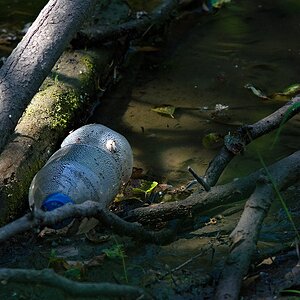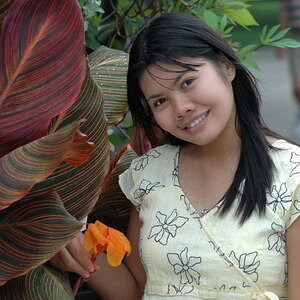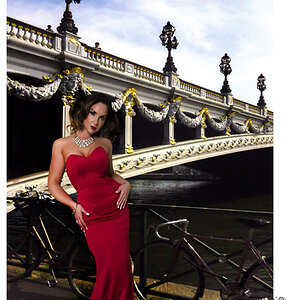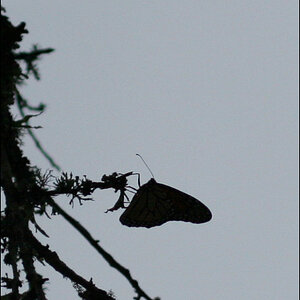Navigation
Install the app
How to install the app on iOS
Follow along with the video below to see how to install our site as a web app on your home screen.

Note: This feature currently requires accessing the site using the built-in Safari browser.
More options
You are using an out of date browser. It may not display this or other websites correctly.
You should upgrade or use an alternative browser.
You should upgrade or use an alternative browser.
1/500th flash syn - give some examples
- Thread starter NateS
- Start date
schumionbike
TPF Noob!
- Joined
- Mar 9, 2007
- Messages
- 1,083
- Reaction score
- 0
- Location
- Houston, Texas
- Can others edit my Photos
- Photos OK to edit
Can someone explain to me why a higher sync flash tend to put more light from the flash into the picture versus dragging the shutter which allow more ambient light in the picture?
Garbz
No longer a newbie, moving up!
- Joined
- Oct 26, 2003
- Messages
- 9,713
- Reaction score
- 203
- Location
- Brisbane, Australia
- Website
- www.auer.garbz.com
- Can others edit my Photos
- Photos NOT OK to edit
Because shutter speed and flash duration are not related until it gets out of sync. Typical shutter speeds range from anything up to 1/8000th of a second on a high end DSLR. A flash however has a duration from 1/40000th of a second up to 1/2000th or so depending on it's power output.
So assuming you're shooting below sync speed at 1/250th. The flash fires for a tiny duration while the entire sensor is exposed. If you open up the shutter you let more ambient light in but the flash still fires for the same tiny duration.
Above 1/250th the entire sensor is not exposed at once, meaning the rear curtain of the shutter starts closing before the front curtain has finished opening. It's literally dragging a slit across the frame. To illuminate the scene the flash has to fire multiple times. so at 1/500th the flash in high speed sync would have to fire twice, once to illuminate the scene when the first half of the sensor is exposing, and then again when the second half is exposing. Thus more power is drawn from the flash and you've effectively limited your max power output capability of the flash.
So assuming you're shooting below sync speed at 1/250th. The flash fires for a tiny duration while the entire sensor is exposed. If you open up the shutter you let more ambient light in but the flash still fires for the same tiny duration.
Above 1/250th the entire sensor is not exposed at once, meaning the rear curtain of the shutter starts closing before the front curtain has finished opening. It's literally dragging a slit across the frame. To illuminate the scene the flash has to fire multiple times. so at 1/500th the flash in high speed sync would have to fire twice, once to illuminate the scene when the first half of the sensor is exposing, and then again when the second half is exposing. Thus more power is drawn from the flash and you've effectively limited your max power output capability of the flash.
schumionbike
TPF Noob!
- Joined
- Mar 9, 2007
- Messages
- 1,083
- Reaction score
- 0
- Location
- Houston, Texas
- Can others edit my Photos
- Photos OK to edit
Because shutter speed and flash duration are not related until it gets out of sync. Typical shutter speeds range from anything up to 1/8000th of a second on a high end DSLR. A flash however has a duration from 1/40000th of a second up to 1/2000th or so depending on it's power output.
So assuming you're shooting below sync speed at 1/250th. The flash fires for a tiny duration while the entire sensor is exposed. If you open up the shutter you let more ambient light in but the flash still fires for the same tiny duration.
Above 1/250th the entire sensor is not exposed at once, meaning the rear curtain of the shutter starts closing before the front curtain has finished opening. It's literally dragging a slit across the frame. To illuminate the scene the flash has to fire multiple times. so at 1/500th the flash in high speed sync would have to fire twice, once to illuminate the scene when the first half of the sensor is exposing, and then again when the second half is exposing. Thus more power is drawn from the flash and you've effectively limited your max power output capability of the flash.
Wow thanks for the explaination!!!
Mav
TPF Noob!
- Joined
- Jan 1, 2008
- Messages
- 1,457
- Reaction score
- 2
- Can others edit my Photos
- Photos OK to edit
Because like Garbz said, the flash burst duration is very very shot, like 1/1000s at full power to maybe 1/10,000s at lower power levels. When you're able to use a faster shutter speed with a flash you're proportionally capturing more of the flash burst and less of the ambient light. It's a balance.Can someone explain to me why a higher sync flash tend to put more light from the flash into the picture versus dragging the shutter which allow more ambient light in the picture?
There's a good diagram and overall explanation here: http://www.kenrockwell.com/tech/syncspeed.htm
NateS
TPF Noob!
- Joined
- Sep 27, 2007
- Messages
- 2,750
- Reaction score
- 39
- Location
- Missouri
- Can others edit my Photos
- Photos NOT OK to edit
Great examples Mav and I can see how it is useful in brighter light. I'm gonna start trying this outside with pictures of our son. Seems like a lot of flexibility on the effects of a faster flash sync speed.
Village Idiot
No longer a newbie, moving up!
- Joined
- Mar 20, 2008
- Messages
- 7,269
- Reaction score
- 406
- Location
- Shepherdsturd, WV / Almost, MD
- Can others edit my Photos
- Photos NOT OK to edit
Pssst. Nikon lied. You can sync their electronic shutter cameras to a much faster x sync speed. Up to 1/8000. I think that's the limitation of the camera.
NateS
TPF Noob!
- Joined
- Sep 27, 2007
- Messages
- 2,750
- Reaction score
- 39
- Location
- Missouri
- Can others edit my Photos
- Photos NOT OK to edit
Pssst. Nikon lied. You can sync their electronic shutter cameras to a much faster x sync speed. Up to 1/8000. I think that's the limitation of the camera.
How exactly do you do this? I tried and it only let's me take the shutter speed to 1/500 with the flash on and in manual mode. D70s by the way.
Here's my humbled attempts at 1/500th from yesterday.
1/500th, f/22

1/500, f/20

1/500, f/8

I had to use a ridiculously small aperature to get the darkening of the background (f20, f22) which is somewhat silly for portraits. I guess maybe it was just too bright of a day out.
Village Idiot
No longer a newbie, moving up!
- Joined
- Mar 20, 2008
- Messages
- 7,269
- Reaction score
- 406
- Location
- Shepherdsturd, WV / Almost, MD
- Can others edit my Photos
- Photos NOT OK to edit
You have to attach it so it sees a flash and not the TTL. Radio trigger, optical trigger, sync cable, etc...
You can get a sync cable for less than $5. It won't be very long, but it will let you play. Also, you can get a cheap set of radio slaves from gadgetinfinity.com or ebay. They're cheap and not the most reliable thing in the world, but they'll let you experiment and spending $30 beats spending $200-$400 for a "pro" set of triggers if you're not planning on spending any more money.
Plus, does the SB600 have an optical slave mode? That may work. I remember using a nikon flash at a meetup we had where it was set as an optical slave.
www.strobist.com
Be careful. It's addicting.
You can get a sync cable for less than $5. It won't be very long, but it will let you play. Also, you can get a cheap set of radio slaves from gadgetinfinity.com or ebay. They're cheap and not the most reliable thing in the world, but they'll let you experiment and spending $30 beats spending $200-$400 for a "pro" set of triggers if you're not planning on spending any more money.
Plus, does the SB600 have an optical slave mode? That may work. I remember using a nikon flash at a meetup we had where it was set as an optical slave.
www.strobist.com
Be careful. It's addicting.
Most reactions
-
 457
457 -
 288
288 -
 270
270 -
 268
268 -
 213
213 -
 189
189 -
 179
179 -
 178
178 -
 176
176 -
 172
172 -
 162
162 -
 126
126 -
 117
117 -
I
108
-
 94
94


![[No title]](/data/xfmg/thumbnail/32/32699-3434a76363cb383404e00a3cd5ed5728.jpg?1619735601)
![[No title]](/data/xfmg/thumbnail/41/41928-733459df56e3fa2fe957f910305d4e37.jpg?1619739945)
![[No title]](/data/xfmg/thumbnail/31/31980-e5048a424621c7b3cd0d306d63c09d67.jpg?1619735137)
![[No title]](/data/xfmg/thumbnail/34/34129-d703825af0884060da6dd68f74046ef3.jpg?1619736300)

![[No title]](/data/xfmg/thumbnail/41/41931-485b5f9a9f3736e9ed9d96ecdf639921.jpg?1619739946)
![[No title]](/data/xfmg/thumbnail/32/32700-18534997be82e5150c566a9e67a00471.jpg?1619735602)



![[No title]](/data/xfmg/thumbnail/34/34128-13fc5c1fff2d14776c9fae00b71ea084.jpg?1619736299)